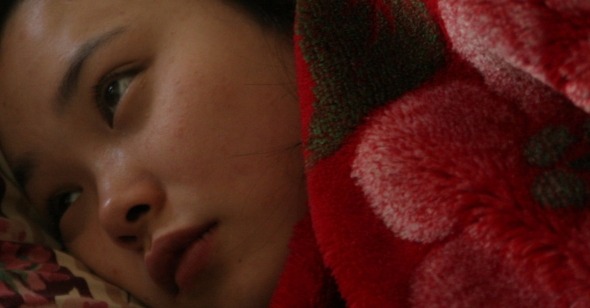Seeing Clearly
by Kristi Mitsuda
In Between Days
Dir. So Young Kim, Kino, U.S.
An exception within the still roughly circumscribed realm of Asian-American narrative cinema, So Young Kim’s lovely debut succeeds in blending cultural specificity with generic humanity for a quietly revelatory portrait. As simplistic as that sounds, few other representations of Asian Americans—Eric Byler’s Charlotte Sometimes comes to mind, along with (yes, that’s right) Harold and Kumar Go to White Castle—manage to acknowledge both difference and similarity at once. In Between Days takes a matter-of-fact approach in its description of a newly landed Korean immigrant and in neither ignoring nor belaboring the issue of race transcends it to a universal realm. Though it may not trumpet itself as a groundbreaking “event” along the lines of the flashier but emptier Better Luck Tomorrow, make no mistake: In Between Days is an original. But despite its glowing notices from Sundance 2006 and numerous “Best Undistributed” mentions on year-end lists, it languished for so long without distribution that I feared it might never see the dark of a cinema. Finally, thankfully, picked up by Kino and programmed by the IFC Center in New York, it finds theatrical release this week.
It opens with what will become its defining shot: furry-hooded Aimie in close-up, trudging through the snow, backed by an indistinguishable cityscape of tall buildings and power lines; she could be in any random wintry city in North America. Kim keeps the camera disorientingly proximate—you’d be hard-pressed to find an establishing shot within the movie’s duration—and through this deliberate withholding of spatial information creates a sense of displacement and isolation, which we soon recognize is an approximation of Aimie’s particular experience. Like most teenagers, she has endearingly bad skin, doodles in her notebook when she should be paying attention in class, and drinks coffee very seriously. But the typical insecurity marking adolescence is heightened by the anxiety of assimilation present in every English-language encounter and the threat presented by an Americanized Korean girl’s interest in her best friend—also a recent arrival to the States—and secret crush, Tran (Taegu Andy Kang). The filmmaker sensitively limns (in concert with a radiant, naturalistic performance by a nonprofessional Jiseon Kim) the unutterable loneliness.
We spend most of our time cramped into intimate quarters with the pair, bearing witness to their playful rapport, which quickly takes on experimental sexual overtones. A textured minimalism animates the repetition of images found in the film, the cycling of which charts a constellation made up of commutes to and from school through the snow, waits in the city light–reflecting glass of the bus stop shelter, and walks on the highway overpass. The visual design works on numerous thematic levels, voicing Aimie’s narrowly defined existence—dotted with the usual distractions of cell phones, video games, and karaoke—while mapping the insular experience of teenage alienation. This imposed myopia and seasonal gloom necessitates an inward gaze: You’re reminded of being that age and how one crush can consume your entire world. By tracing Aimie’s home life in deft sketches, Kim suggests how Tran becomes—more than mere love object—the repository of Aimie’s yearnings for connection, lacking elsewhere. She lives with her single mother—who never seems to be home and with whom she discusses little outside the topic of her studies—and narrates letters to her father, who abandoned them. In achingly plaintive sequences, she ruminates in voiceover set to images of the city skyline (“I miss you so much; But don’t you miss me?”). The longing present in these static shots, in rare macro views which encompass the glimmering distance, throbs through the screen.
With its director’s fine-tuned formal expressiveness and attentiveness to Aimie’s moods, smiles, and tears, In Between Days breathtakingly captures the open sore aspect of those years. Kim’s eloquent articulation of Aimie and Tran’s inability to communicate fully with one another in the familiarly transparent way of teens provides jolts of recognition: secret smiles when Aimie finds out that Tran won’t be going to her rival’s party, Tran’s avid interrogation after he sees Aimie sharing a cigarette (she never smokes) with another boy, the giving of a gift—a bracelet which Aimie’d been eyeing for weeks, and which she dropped an English class to afford—passed off to Tran with a flippant, “I saw this and thought it would look cool on you.” They constantly test one another, pushing the boundaries of their friendship to see how much it can hold. Each infinitesimal gesture has dramatic ripple effects, requiring an equal and opposite reaction for transgressions perceived—evident most wrenchingly in the concluding scene—and this acting out is sympathetically conveyed for what it is: a balm on the wound.
